The roscón de Reyes is an emblem of Christmas in Spain. But in other countries they also have typical cakes to eat on 6 January. We have selected 5 Three Kings sweets from different parts of the world in case you fancy a different proposal, or if you have such a sweet tooth that you want to try them all.
Bolo Rei (Portugal)
It is a Portuguese tradition that began in the second half of the 19th century. In terms of appearance, it is very similar to the typical roscón de Reyes, but it is different because the dough is made with sultanas and dried fruits such as walnuts, almonds or pine nuts. It is also flavoured with port wine.
Galettes des rois (Francia)
The galette des rois is a traditional French cake eaten on Epiphany (6 January). It is made of puff pastry and is usually filled with frangipane, a cream made from sweet almonds, butter, eggs and sugar. There are also other varieties of chocolate, apple or candied fruit. It is also typical for a bean to be hidden inside.
Rosca de Reyes (Mexico)
The “rosca de Reyes” is a tradition in Mexico on the 6th of January. It comes from Spain and is a sweet similar to the typical Spanish roscón de Reyes, but with some differences. The main difference are the crusts that accompany the candied fruit and quince jelly. They are strips of dough that become crunchy and delicious when baked. In addition, a figurine is usually hidden inside. Whoever wins, commits to buying or preparing the traditional tamales for Candlemas Day, a Mexican holiday celebrated on 2 February.
King Cake (New Órleans, United States)
This colourful sweet is a typical New Orleans recipe. It is similar in appearance to a cake, but is made with a mixture of coffee cake and cinnamon roll; it is usually filled with fruit and cream cheese. It is also decorated with yellow, green and purple colours, which are typical of Mardi Gras (Shrove Tuesday), the traditional parade to celebrate Carnival. Although it is eaten during Carnival, it starts to be sold from 6 January, which for them means the countdown to their party. Of course, a figure is also hidden, and whoever gets it must pay for the roscón.
Dreikönigskuchen (Switzerland and Germany)
Although it may have an unpronounceable name for us, it is none other than an Epiphany cake, a typical sweet in Switzerland and Germany to celebrate the arrival of the Three Wise Men. It is made from sweet yeast dough which is formed into balls, arranged in the shape of a flower and sprinkled with flaked almonds and icing sugar. A king is also hidden inside, and is decorated with a golden crown. It is a widespread custom in the country. In fact, approximately 1.5 million of these Three Kings cakes are sold every year.
And if instead of these Three Kings sweets from around the world, you still want to opt for our typical roscón, we have selected 12 of the best roscones from all over Spain.
Click here to read the Spanish version.





